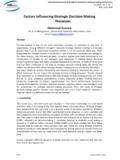Transcription of Issues in Information Systems - IACIS
1 Issues in Information Systems Volume 16, issue II, pp. 81-90, 2015 81 BIG DATA ANALYTICS Jasmine Zakir, Minot State University, Tom Seymour, Minot State University, Kristi Berg, Minot State University, ABSTRACT Today Big Data draws a lot of attention in the IT world. The rapid rise of the Internet and the digital economy has fuelled an exponential growth in demand for data storage and analytics, and IT department are facing tremendous challenge in protecting and analyzing these increased volumes of Information . The reason organizations are collecting and storing more data than ever before is because their business depends on it. The type of Information being created is no more traditional database-driven data referred to as structured data rather it is data that include documents, images, audio, video, and social media contents known as unstructured data or Big Data.
2 Big Data Analytics is a way of extracting value from these huge volumes of Information , and it drives new market opportunities and maximizes customer retention. This paper primarily focuses on discussing the various technologies that work together as a Big Data Analytics system that can help predict future volumes, gain insights, take proactive actions, and give way to better strategic decision-making. Further this paper analyzes the adoption, usage and impact of big data analytics to the business value of an enterprise to improve its competitive advantage using a set of data algorithms for large data sets such as Hadoop and MapReduce. Keywords: Big Data, Analytics, Hadoop, MapReduce INTRODUCTION Big Data is an important concept, which is applied to data, which does not conform to the normal structure of the traditional database.
3 Big Data consists of different types of key technologies like Hadoop, HDFS, NoSQL, MapReduce, MongoDB, Cassandra, PIG, HIVE, and HBASE that work together to achieve the end goal like extracting value from data that would be previously considered dead. According to a recent market report published by Transparency Market Research, the total value of big data was estimated at $ billion as of 2012, but by 2018, it s expected to reach the staggering level of $ billion that s almost a 700 percent increase [29]. Forrester Research estimates that organizations effectively utilize less than 5 percent of their available data. This is because the rest is simply too expensive to deal with.
4 Big Data is derived from multiple sources. It involves not just traditional relational data, but all paradigms of unstructured data sources that are growing at a significant rate. For instance, machine-derived data multiplies quickly and contains rich, diverse content that needs to be discovered. Another example, human-derived data from social media is more textual, but the valuable insights are often overloaded with many possible meanings. Big Data Analytics reflect the challenges of data that are too vast, too unstructured, and too fast moving to be managed by traditional methods. From businesses and research institutions to governments, organizations now routinely generate data of unprecedented scope and complexity.
5 Gleaning meaningful Information and competitive advantages from massive amounts of data has become increasingly important to organizations globally. Trying to efficiently extract the meaningful insights from such data sources quickly and easily is challenging. Thus, analytics has become inextricably vital to realize the full value of Big Data to improve their business performance and increase their market share. The tools available to handle the volume, velocity, and variety of big data have improved greatly in recent years. In general, these technologies are not prohibitively expensive, and much of the software is open source. Hadoop, the most commonly used framework, combines commodity hardware with open-source software.
6 It takes incoming streams of data and distributes them onto cheap disks; it also provides tools for analyzing the data. However, these technologies do require a skill set that is new to most IT departments, which will need to work hard to integrate all the relevant internal and external sources of data. Although attention to technology isn t sufficient, it is always a necessary component of a big data strategy. This paper discusses some of the most commonly used big data technologies mostly open source that work together as a big data analytics system for leveraging large quantities of unstructured data to make more informed decisions. Issues in Information Systems Volume 16, issue II, pp. 81-90, 2015 82 REVIEW OF LITERATURE Big Data is a data analysis methodology enabled by recent advances in technologies that support high-velocity data capture, storage and analysis.
7 Data sources extend beyond the traditional corporate database to include emails, mobile device outputs, and sensor-generated data where data is no longer restricted to structured database records but rather unstructured data having no standard formatting [30]. Since Big Data and Analytics is a relatively new and evolving phrase, there is no uniform definition; various stakeholders have provided diverse and sometimes contradictory definitions. One of the first widely quoted definitions of Big Data resulted from the Gartner report of 2001. Gartner proposed that, Big Data is defined by three V s volume, velocity, and variety. Gartner expanded its definition in 2012 to include veracity, representing requirements about trust and uncertainty pertaining to data and the outcome of data analysis.
8 In a 2012 report, IDC defined the 4th V as value highlighting that Big Data applications need to bring incremental value to businesses. Big Data Analytics is all about processing unstructured Information from call logs, mobile-banking transactions, online user generated content such as blog posts and tweets, online searches, and images which can be transformed into valuable business Information using computational techniques to unveil trends and patterns between datasets. Another dimension of the Big Data definition involves technology. Big Data is not only large and complex, but it requires innovative technology to analyze and process. In 2013, the National Institute of Standard and Technology (NIST) Big Data workgroup proposed the following definition of Big Data that emphasizes application of new technology; Big Data exceed the capacity or capability of current or conventional methods and Systems , and enable novel approaches to frontier questions previously inaccessible or impractical using current or conventional methods.
9 Business challenges rarely show up in the appearance of a perfect data problem, and even when data are abundant, practitioners have difficulties to incorporate it into their complex decision-making that adds business value. In 2012, McKinsey & Company conducted a survey of 1,469 executives across various regions, industries and company sizes, in which 49 percent of respondents said that their companies are focusing big data efforts on customer insights, segmentation and targeting to improve overall performance [10] An even higher number of respondents 60 percent said their companies should focus efforts on using data and analytics to generate these insights. Yet, just one-fifth said that their organizations have fully deployed data and analytics to generate insights in one business unit or function, and only 13 percent use data to generate insights across the company.
10 As these survey results show, the question is no longer whether big data can help business, but how can business derive maximum results from big data. Predictive Analytics Predictive Analytics is the use of historical data to forecast on consumer behavior and trends [18]. It is the use of past/historical data to predict future trends. This analysis makes use of the statistical models and machine learning algorithms to identify patterns and learn from historical data [25]. Predictive Analysis can also be defined as a process that uses machine learning to analyze data and make predictions [22]. Sixty seven percent of businesses aim at using predictive analytics to create more strategic marketing campaign in future, and 68% sight competitive advantage as the prime benefit of predictive analysis [17].







